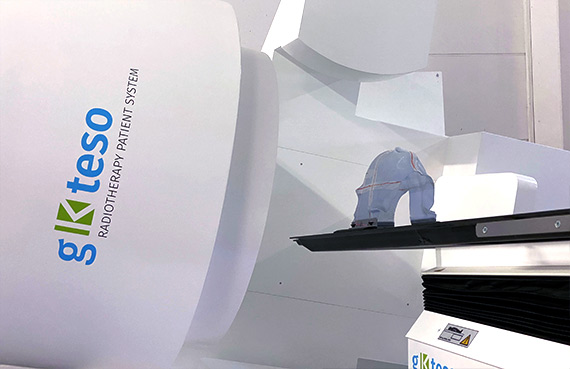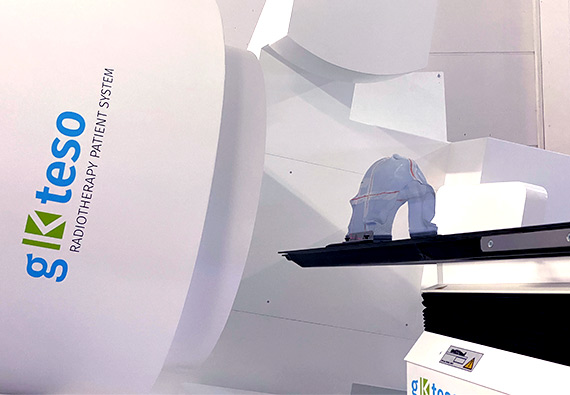RPS base – Radiotherapy treatment
Treatment table with
integrated 6 DoF
- Isocenter correction in perfection
- Smart user interface
- Big correction areas

More range for more correction
possibilities
Angle correction up to +/- 5 degress
on each axis
With the help of image-guided radiotherapy, the reliability and safety of treatment with the linear accelerator for radiotherapy has been continuously improved over recent years for the benefit of those being treated. Image-guided radiotherapy is also very good at detecting intrafraction motion, which is difficult to predict and can occur as a result of repositioning the patient prior to each radiotherapy session. Intrafraction motion results from elasticities and minimal head shape changes and can only be reduced as best as possible by using external fixation systems, such as thermoplastic masks. Through the use of image-guided radiotherapy, once the patient is positioned under the linear radiotherapy accelerator, this can be almost completely corrected with the help of our RPS base. The RPS base is a fully integrated 6DoF system that can correct each axis of rotation by up to five degrees – even while the patient is already immobilized on the patient table. This allows a wider range of correction options and improves the quality of treatment and reliability of the radiotherapy.
- Stereotactic radiotherapy
- Penumbra in radiotherapy
- Radiotherapy mask
- Image guided radiotherapy
- Brain radiotherapy
- Fractioned radiotherapy
More range for more correction possibilities
+49 8234 966 38 41
- More range for more correction possibilities
- Production company for linac parts
- Patient positioning without compromises
The „RPS Base“ Treatment table with integrated 6 DoF
We are looking forward to your inquiry!
6-DoF couch without any compromise
- Fully integrated 6DoF
- application programmed
- interface (API)
- Low entrance high
- Prepared for new technologies
Production company for linac parts
GKteso produces much parts for OEM customers Linac radiotherapy
As a manufacturer of components for radiotherapy, gKteso has been developing and manufacturing parts for Linac machines for many years. The RPS base is a treatment table with fully integrated 6D functionality and can be easily customized. According to a report on the radiotherapy market, a Linac machine is used for one in two cancer patients during the course of treatment. According to the report on the radiotherapy market, demand could continue to rise due to demographic population trends. By 2030, the number of new cases could reach 600,000 people annually in Germany alone. The RPS base is an optimized motion system for new Linac machines. State-of-the-art Linac parts, such as the RPS base, which are already prepared for cutting-edge technologies and treatments, enable Linac manufacturers to achieve faster time-to-market strategies at lower Linac development costs.
Patient positioning without compromises
Fully integrated 6 DOF couch with low entrence hight
Immobilization during radiotherapy is always particularly important when surrounding risk structures in the patient’s body are to be spared as much as possible. The safety concept is supported by CBCT imaging in radiotherapy. For example, brain tumors can be optimally positioned and treated in the isocenter. With CBCT imaging in radiotherapy, the patient’s risk of serious side effects is reduced as much as possible. Patient positioning during radiotherapy and immobilization during radiotherapy require accurate systems that are as comfortable as possible for the patient. The RPS base was developed to meet both requirements: The low entry height, load-bearing capacity and safety of the RPS base directly help the patient. The 6DoF movement options and correction variants support the practitioners in optimally positioning the tumor in the isocenter for radiotherapy and immediately correcting deviations between the real position and the planning data.
Datasheet – RPS base
(RPS base – Technical data)
6 DoF Robotic Couch System
for Radiotherapy Cancer Treatments

Stereotactic radiotherapy

Penumbra in radiotherapy
Radiotherapy with a Linac machine is involved in about 50 percent of permanent tumor cures. New radiotherapy treatments have evolved more rapidly in recent decades than in almost any other medical discipline. Radiotherapy side effects continue …

Radiotherapy mask
The RPS base is the patient couch for radiotherapy with the greatest flexibility. As a completely integrated system, RPS base can be individually adapted to all Linac machines. Depending on the choice of carbon plate, the RPS base …
Image guided radiotherapy
4D radiotherapy is also called body stereotaxy because this procedure can safely treat moving tumors. Without the advances made by 4DMI (4D Medical Imaging), it would not have been possible to precisely irradiate tumors in the lung area just a few years ago, because these sometimes change their position by several centimeters due to respiratory movements …
Brain radiotherapy
Head and neck radiotherapy is usually a part of an overall therapy approach which may consist of surgery, chemotherapy, and head and neck radiotherapy. For radiotherapy in the brain, it is crucial to spare the surrounding tissue as much as possible. Immobilization for radiotherapy is therefore particularly important. The RPS base…
Fractioned radiotherapy
Preparation for radiotherapy is complex because the position and contours of the tumor must be determined precisely during planning. Radiotherapy for brain tumors must be particularly precise, because there are always important regions within the head in the immediate vicinity …
Radiotherapy mask
The RPS base is the patient couch for radiotherapy with the greatest flexibility. As a completely integrated system, RPS base can be individually adapted to all Linac machines. Depending on the choice of carbon plate, the RPS base interfaces with all common add-ons for radiotherapy, such as a thermoplastic shell for radiotherapy. The choice of thermoplastic shell for radiotherapy has a great influence on the quality of fixation of the patient and is especially important for the treatment of brain tumors in order to minimize stereotactic radiotherapy side effects. Minimal changes in the patient’s position can lead to undesirable side effects during stereotactic radiotherapy. Reliable fixation and the precise correction options provided by the RPS base create additional treatment safety. Do not compromise on 6D patient couches and choose the RPS base from the outset.


Image guided radiotherapy
4D radiotherapy is also called body stereotaxy because this procedure can safely treat moving tumors. Without the advances made by 4DMI (4D Medical Imaging), it would not have been possible to precisely irradiate tumors in the lung area just a few years ago, because these sometimes change their position by several centimeters due to respiratory movements, both during diagnosis and during irradiation. Only by combining image guidance systems such as 4D diagnostic scans and radiotherapy imaging can quality be improved. The latest image guidance systems such as 4D CT scans now allow contouring of the treatment area as a function of the respiratory phase. In combination with radiotherapy imaging, this position can be checked on the linear accelerator prior to treatment and deviations detected during radiotherapy imaging can be corrected immediately with our RPS base. Subsequently, by gating in 4D radiotherapy, radiation is administered only in the time periods in which the respiratory phase is the same. Image-guided 4D radiotherapy achieves high reproducibility even with repeated irradiation.

Brain radiotherapy
Head and neck radiotherapy is usually a part of an overall therapy approach which may consist of surgery, chemotherapy, and head and neck radiotherapy. For radiotherapy in the brain, it is crucial to spare the surrounding tissue as much as possible. Immobilization for radiotherapy is therefore particularly important. The RPS base offers all the features needed to combine patient comfort with immobilization for radiotherapy: low entry height, compatibility with common indexing systems, and large 6D adjustment ranges to compensate for deviations in immobilization. For radiotherapy in the brain, thermoplastic face masks are usually used which are attached to the patient couch and stabilize the patient’s head as effectively as possible during radiation. The RPS base can support most indexing systems and is therefore compatible with all thermoplastic masks. Gkteso solutions for radiotherapy include integrated complete systems as well as 6DoF couch attachments with numerous correction options or simple add-ons for the correction of angular errors

Penumbra in Radiotherapy
Also available for Tomo therapy
systems Improve the accuracy
Radiotherapy with a Linac machine is involved in about 50 percent of permanent tumor cures. New radiotherapy treatments have evolved more rapidly in recent decades than in almost any other medical discipline. Radiotherapy side effects continue to be reduced and treatment is becoming more and more tolerable for patients. Radiotherapy with a Linac machine allows tumors to be treated with pinpoint accuracy. New radiotherapy treatments, such as image-guided techniques, continue to improve treatment options. Experts see the future of radiotherapy as involving the expansion of highly effective radiotherapy with hydrogen ions or carbon ions. In particular, tumors that were previously difficult to manage with radiotherapy can be reached with it. In the future, the penumbra in radiotherapy will also be further reduced so that the radiation acuity is improved. Innovative patient couches like the RPS base help radiation medicine move patients closer to the gantry and reduce the penumbra.

Fractioned radiotherapy
Preparation for radiotherapy is complex because the position and contours of the tumor must be determined precisely during planning. Radiotherapy for brain tumors must be particularly precise, because there are always important regions within the head in the immediate vicinity of the tumor. Appropriate tools are used to best implement this planning data in radiotherapy. Immobilization aids for radiotherapy are available for all areas of the body. For brain tumor radiotherapy, thermoplastic face masks are usually used, which are custom-molded for each patient. By using the RPS base, the minimal positioning errors that occur during the preparation of radiotherapy can be readjusted. Depending on the radiotherapy immobilization aid used, i.e. depending on the indexing system, different carbon boards of the RPS base are available.

Stereotactic radiotherapy
Sub degree correction
Imaging protocols are used for stereotactic radiotherapy to improve the quality of treatment. These imaging protocols ensure that once the image distortions have been automatically corrected, the images can be immediately processed in the treatment planning system. Due to its great accuracy, stereotactic radiotherapy also enables the treatment of complex brain tumors with a Linac linear accelerator. The RPS base helps to position the patient as accurately as possible under the Linac linear accelerator and expands the range of possible irradiation angles thanks to its 6DoF mobility. Patients can be positioned and fixed without compromise so that stereotactic radiotherapy captures tumor tissue without affecting critical structures. Without changing the treatment plan, the RPS base allows corrections to be implemented immediately prior to radiotherapy.


RPS SGRT
Motion management during treatment. Correction of motion during radiation in combination with surface scanner

RPS Mini
Multiple brain metastases corrected via XVI Data
The 6 DoF add on couch allows correction after cone beam CT.

RPS head
The most favourable solution of angle correction in radiotherapy. Better results In combination with several thermal masks.

RPS fixedbeam
Innovative solutions in radiotherapy treatment. Open a new direction of cost reduction with gkteso.











